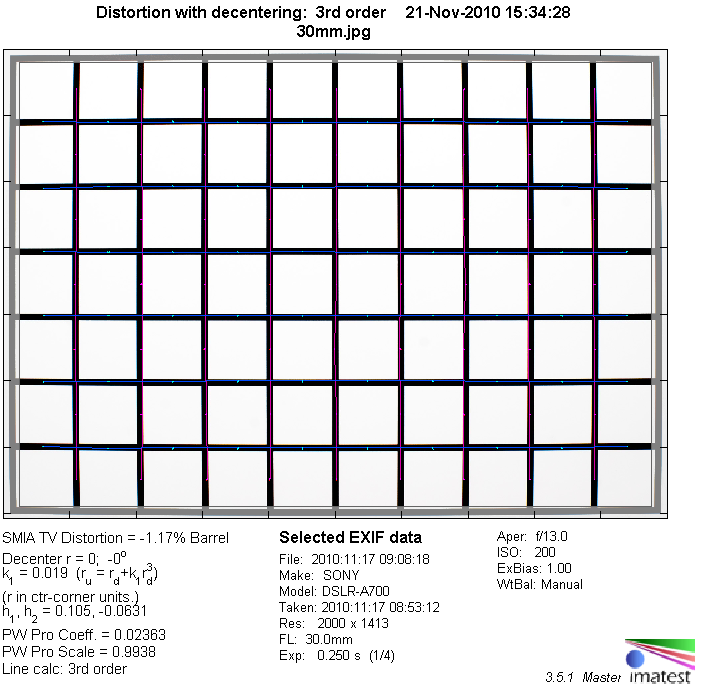|
Sony 30mm f/2.8 DT macro ( SAL-30F28 ) - Lab Test / Review - Analysis |
|
Lens Reviews -
Sony Alpha/NEX (APS-C)
|
|
Page 2 of 2

Distortion
The Sony lens produces a slight to moderate amount of barrel distortion (~1.2%). This is usually not relevant in field conditions unless you're intending to use the lens for repro work (which is a typical application for macro lenses).

Vignetting
The 30mm f/2.8 covers the APS-C image circle only so it produces a comparatively high amount of vignetting. At f/2.8 it exceeds 1.5EV which can be critical in some scenes. Stopping down to f/4 resolves the worst part but you need to stop down to f/5.6 to eliminate the problem altogether.

MTF (resolution)
The Sony lens delivery very good to excellent resolution results during our MTF tests. The center performance is already excellent straight at f/2.8 and the borders/corner follow on a very good and good+ level. The performance peak is reached around f/5.6 with an excellent image quality across most of the image. Diffraction effects start to have a higher impact beyond f/11 but f/16 remains perfectly usable. Except some softness at f/22 but that's normal at such settings and the Sony 30mm DT is better than most here. The tested sample showed a slight centering defect at f/2.8.
Please note that the MTF results are not directly comparable across the different systems!
Below is a simplified summary of the formal findings. The chart shows line widths per picture height (LW/PH) which can be taken as a measure for sharpness.
If you want to know more about the MTF50 figures you may check out the corresponding Imatest Explanations
Chromatic Aberrations (CAs)
Lateral chromatic aberrations (color shadows at harsh contrast transitions) are very low at large aperture settings but the issue worsens the more you stop down. It's getting more obvious beyond f/8 but it does never reach overly critical levels.

Bokeh
Out-of-focus highlights show a strong outlining effect as well as a vignetting effect (cat's eyes) at very large apertures. This improves when stopping down to f/5.6 which is rather "late". The blur in the critical focus transition zone is pretty smooth and buttery. All-in-all a mixed bag here.

Bokeh Fringing / Longitudinal Chromatic Aberrations (LoCA)
Bokeh fringing, also called "LoCAs", is a color fringing effect at hard contrasts with purple halos in front and green halos beyond the focus point. The Sony lens shows some bokeh fringing at f/2.8 and a few traces at f/4 but it's certainly no show-stopper.
|
Move the mouse cursor over the f-stop marks below to observe the respective LoCAs
|
| f/2.8 |
f/4 |
f/5.6 |
|

|
Verdict
The Sony 30mm f/2.8 DT macro ( SAL-30F28 ) shines in many aspects. Like most dedicated macro lenses it is extremely sharp straight from f/2.8 till about f/11 and even f/16 can be considered as a mainstream setting. Lateral CAs are absolutely negligible at large apertures but you may spot them at times at and beyond f/11. The amount of barrel distortion is slightly higher than average for a macro lens but in absolute terms it's still very moderate. Typical for a dedicated APS-C format lens it shows rather heavy vignetting at max. aperture. The bokeh is generally smooth and buttery but out-of-focus highlight show a less than pleasing outlining - possibly the weakest optical aspect of the lens. The bokeh fringing can be just visible at f/2.8 but dissolves soon thereafter.
Just like most of its "DT" cousins it is a budget lens and it shows in its build quality - it is a plastic lens down to the mount. The SAM AF drive struggles somewhat to move the inner tubes throughout the focus range. A focus limiter would have been a good idea here. The AF accuracy is fine though. Possibly the nicest aspect of the Sony lens is its pricing. At less than 200EUR/US$ it's really a steal in relation to its capabilities.
|